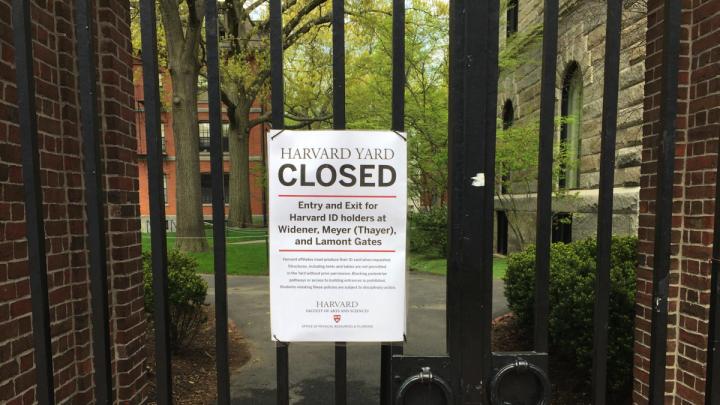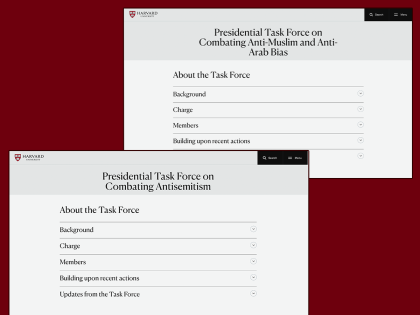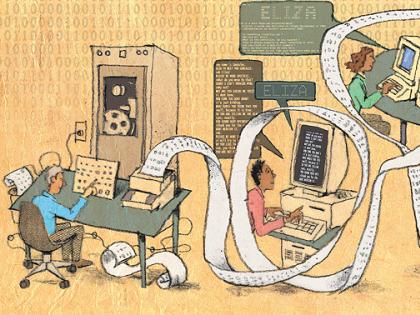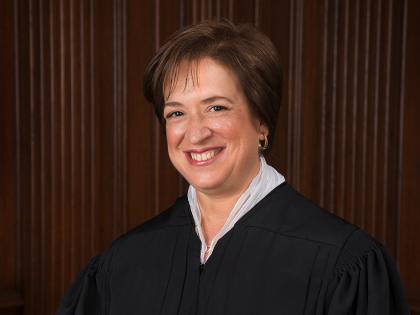The lingering symbols of this past spring semester are surely the laminated signs, zip-tied to locked iron gates, starkly stating, “Harvard Yard Closed” and directing those with University IDs to use the Widener, Meyer, or Lamont gates, where security guards scanned them in. To be sure, the ability to lock the gates and isolate the Yard—ultimately combined with the decision of Harvard leaders and the Harvard Out of Occupied Palestine (HOOP) protestors encamped there for 20 days to talk with one another—avoided the kind of police confrontation that marred many campuses in April and May. But their continued closure, even beyond Commencement (page 10), fairly represented a community divided by difficult issues, with continuing challenges aplenty in the near future: first-year student registration begins August 19.
The protest aside, much of the term unfolded as interim president Alan M. Garber and interim provost John F. Manning might have hoped it would when they organized groups of faculty members to address campus crises that evolved, or deepened, during the year.
At the May 7 Faculty of Arts and Sciences (FAS) meeting, for example, leaders of the task forces on combating anti-Muslim and anti-Arab bias, and combating antisemitism, respectively, reported on what they had learned from conversations with students, faculty, and staff. Their disturbing findings suggest that those exchanges had been frank. That they also overlapped perhaps pointed toward common remedies.
Ali Asani, Albertson professor of Middle Eastern studies and professor of Indo-Muslim and Islamic religion and cultures (cochair of the former), sketched “a great deal of anxiety and fear of being targeted” on campus for the mere fact of being, or being perceived as, Arab, Muslim, or Palestinian, amid instances of being doxed and harassed—conditions he described as “frankly, dehumanization.” Frost professor of Jewish history Derek Penslar, cochair of the antisemitism task force, described “a lack of trust, between students and the administration and between students” even preceding the Hamas attack last October 7. His group’s listening sessions highlighted “deep-seated problems,” with “many Jewish affiliates profoundly unnerved” by “social exclusion and shunning.”
Ali said the University faced the challenge of “engaging with and understanding difference, and building bridges,” within the curriculum and beyond, as intentional elements of a Harvard education. That would require training faculty members on new teaching methods and educating the community about religious literacy. Penslar forecast recommendations by the fall semester on Jewish applicants, student life, protests, complaint processes, and discipline.
More generally, Penslar reported a lack of healthy discussion of “controversial subjects” amid pervasive fear and distrust: for an academic community, a sign of things gone off the rails. That was a natural bridge to the working group on open inquiry and constructive dialogue, led by Radcliffe Institute Dean Tomiko Brown-Nagin and professor of government Eric Beerbohm.
FAS professors chimed in constructively, suggesting how focused, small-group classes or case-method teaching could build skills and understanding of even deeply divisive issues: exactly the sort of work the institution needs to do. (Read more at harvardmag.com/fas-task-24.)
Five days after Commencement, the working group on institutional voice recommended that Harvard not take positions on public issues beyond those pertaining to its academic mission (see harvardmag.com/neutrality-24). The Corporation and administration unsurprisingly accepted the recommendation. The details of implementation will be telling, and its effect assumes the public distinguishes between a Harvard voice and those of individual community members. (Such a policy may not have saved the University from fierce criticism last October, when students initially blamed Israel for the terrorist attack by Hamas: institutional expressions of opinion are affected by the new policy; student and faculty voices are not.)
But the opportunities for such progress have been few and far between. Earlier in the meeting, Dean Hopi Hoekstra said that she had hoped to talk about the faculty’s work on artificial intelligence, academic discourse, and related educational matters—but circumstances forced her to address other themes. Strikingly, she described the faculty as owners of a (nearly) 400-year-old house “with good bones” (traditions of academic freedom and excellence), but with “a lot of deferred maintenance” requiring much more than applications of duct tape. Effecting repairs, she said, would require all of the faculty’s talents, joined by commitment to Harvard’s mission and trust in one another. “The events of this year have not strengthened our trust in the institution,” she acknowledged. With sorrow, and some edge, Hoekstra cited one intramural violation of trust: professors’ leak to the Crimson about the contents of an unusual, and private, April 30 meeting of Corporation and FAS members.
Assuming that internal breach is cured, other, larger matters not strengthening trust were on display. That Corporation briefing was in response to faculty concerns about the crises culminating in the resignation of President Claudine Gay on January 2, prompting questions about University governance. The breadth and depth of those concerns were the subject of the second half of the faculty meeting: a debate on whether FAS would join a proposed all-schools group to explore a University-wide faculty senate. (Harvard and Yale are the only peer institutions without such an entity.)
In presenting the motion May 7 and refining it in an extraordinary, additional FAS meeting a week later, Danielle Allen, Conant University Professor, emphasized the need for shared understanding of Harvard policies among faculties, better communication with the administration and governing boards on University policy, and renewed shared governance. Beyond the headline issues, faculty members feel unconsulted on matters ranging from Harvard’s investment in Allston and decisions about budgets to worries about political and donor pressures on campus discourse. Both debates were well-attended and vigorous; four motions to table, defer, or modify the proposal were defeated (see harvardmag.com/senate-debate-24). On June 3, FAS announced that the motion had carried in an online vote, 309 to 146. Other schools’ participation was unknown as of the press deadline. All this percolated in the background as the protest encampment brought some portion of the FAS and the Corporation into open warfare during Commencement week.

That tension was evident May 7 as Manning visited the FAS meeting to explain Garber’s day-earlier message warning that protestors encamped in Harvard Yard since April 24 would be “referred for involuntary leave from their schools” if they persisted—making them ineligible to take exams, live in Harvard housing, or be present on campus. Manning noted that “We all want the occupation of Harvard Yard to end peacefully”—that invoking police action would be a “very last resort.” He also observed that “We are committed to dialogue and engagement”—but that they “do not and cannot” result from demands and encampments. His remarks were greeted with silence.
The subsequent discussion reached none of the matters Hoekstra sketched. Instead, faculty members who supported the protestors and sought to stave off a confrontation like those that left other schools in chaos, or who disagreed with where the line limiting protest was now being drawn, challenged the provost. When asked why students and faculty members who had reached out to the administration to seek conversation had gotten no response, Manning said the president was not aware of any such requests—an answer that provoked derisive laughter from many in attendance.
The next day, in fact, Garber, College dean Rakesh Khurana, and others did meet with protestors, inconclusively. With the Commencement clock ticking, on May 10, HOOP social media posts indicated that Harvard had begun serving students with notices of involuntary leave. Forcible removal of the encampment was unlikely that weekend while parents collected first-year students from Yard dorms at the end of the term, but tension built since the protestors were now, in effect, trespassers on University property.
In the event, further exchanges on May 13 (by which time remaining occupiers were occupying a largely empty campus) resulted in an agreement. As Garber outlined it the next day, he would arrange a meeting with the chair of the Corporation Committee on Shareholder Responsibility (which advises on proxy votes) and others to talk about the endowment, and with Hoekstra to talk with students about academic matters pertaining to Middle East conflicts. He would also urge schools to rescind involuntary leaves and to have their disciplinary boards rule “expeditiously” on cases of “those who participated in the encampment.” The protestors decamped.
On May 17, however, HOOP reported that more than two dozen students had been suspended or placed on probation, including multiple seniors who accordingly could not graduate. Renewed protests ensued, including a weekend march on Garber’s house. On Monday, May 20, at the usually pro forma FAS meeting to approve the registrar’s list of those students in “good standing” who were eligible to graduate and forward it to the Corporation for final blessing, faculty members voted to add the names of 13 seniors to the list of those who should get their diplomas. Amid dueling Crimson editorials and op-eds for and against the students affected, the Corporation responded on May 22 that the faculty’s vote had not restored the affected students to good standing—so they would not receive their diplomas (see harvardmag.com/corp-ruling-24).
And so the harshly critical student speech at Commencement and the walkout of students and faculty members sympathetic to the protestors were set in motion (see “Commencement 372 7/8,” this issue).
That hardly resolved the issues emanating from the encampment. The University and schools don’t comment on disciplinary cases, even in the aggregate. One result is to leave the community uninformed about what are deemed violations of rules and the resulting punishments. For the HOOP encampment (violating rules on the time, place, and manner of protests—civil disobedience for which sanctions ensued), that left interpretation of the outcomes to the protestors. They emphasized the significant undergraduate penalties (probations and suspensions) and students denied timely graduation. Absent University answers to questions about whether those cases involved other, egregious actions (on May 6 Garber cited “reports” about harassment and intimidation by those encamped and their supporters) or past infractions, the facts surrounding different behaviors and punishments remain uncertain. But other participants’ silence about their fates, and additional information, suggest that some professional school protestors may have been merely warned or admonished. Ph.D. students’ cases (involving those from any school enrolled in Graduate School of Arts and Sciences programs) were incomplete at press time; others may still be under appeal.
The lack of clarity may raise more questions about the University’s decentralized structure and governance. Unfortunately, such concerns radiate beyond student and faculty views of the campus culture and parameters for speech and protest. On May 16, the Harvard Jewish Alumni Alliance (HJAA) disseminated “The Soil Beneath the Encampments: How Israel and Jews Became the Focus of Hate at Harvard”—an “audit” of course contents, visiting speakers, social media posts, and more. Its authors requested prompt action on an agenda ranging from enforcing codes of conduct “uniformly and without exception” to such sweeping measures as “an independent, third-party investigation” of “curriculum, events, admissions policies, and student, faculty, or administrator behavior that may violate Harvard’s anti-discrimination policy and/or its anti-bullying policy and/or IHRA definition” (the International Holocaust Remembrance Alliance definition of antisemitism: language HJAA advocates adopting). The same day, the U.S. House Committee on Education and the Workforce released its “investigative update” report on “The Antisemitism Advisory Group and Harvard’s Response: Clarity and Inaction,” arguing that the University was dilatory in responding to campus events after the Hamas attack (read more about both reports at harvardmag.com/antisemitism-reports-24). Neither the concerned alumni nor the congressional investigators seem likely to fold their tents.
An animal-rights protestor’s action on Alumni Day, May 31—throwing material at President Garber—and a pro-Palestinian demonstration closed the unsettled year on an uneasy note (see harvardmag.com/alumni-day-24).
The working group on institutional voice premised its recommendation on enabling community members to “research, teach, and learn,” Harvard’s “core function,” built on a foundation of “free inquiry, intellectual expertise, and productive argument among divergent points of view.”
The space for intellectual debate can seem small and irredeemably polarized. As noted, Dean Hoekstra could barely make room May 7 for such discourse. At least publicly, Harvard has not begun to address how it will respond to the 2023 Supreme Court ruling outlawing affirmative action in admissions. In light of attacks on diversity, equity, and inclusion programs nationwide, HJAA challenged such policies’ “failure to sufficiently include Jews and antisemitism.” Others reject that expansive view, suggesting that DEI initiatives stifle speech and bias hiring at the expense of meritocratic criteria, and so ought to be curtailed or ended. MIT voluntarily ended DEI statements in its hiring practices this spring, and FAS quietly followed suit on June 3, adopting broad “statements of service” instead.
In a baccalaureate understatement, Alan Garber acknowledged the presence of “divergent minds” about current crises but expressed the belief that the “wounds throughout our community…will be slow—but not impossible—to heal.” Given the wounds evident at year-end, it will take more than working group and task force reports to translate his optimism into reality. As the University tries to overcome passionate disputes about policy and governance, and fear of encroaching political pressures, the community might look back in Harvard’s history, and to the arts, to renew the spirit of commitment and trust Hoekstra encouraged. Against the gates secured beyond Alumni Day and a campus locked in contention about its “divergent” opinions, one may hope the closing lines of “Villanelle for an Anniversary,” written by the late Seamus Heaney, Litt.D. ’98 (for the 350th, in 1986), still resonate:
…Here, imagine
A spirit moves, John Harvard walks the yard,
The books stand open and the gates unbarred.








